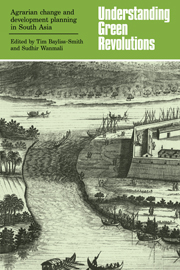Book contents
- Frontmatter
- Contents
- List of contributors
- Preface
- I Understanding Green Revolutions: an overview
- II Agrarian change at village level
- III Development planning and agrarian change
- 12 Rural-based models for rural development: the Indian experience
- 13 Planning and agrarian change in East Africa: appropriate and inappropriate models for land settlement schemes
- 14 Metropolitan expansion in India: spatial dynamics and rural transformation
- 15 Green Revolution and water demand: irrigation and ground water in Sri Lanka and Tamil Nadu
- 16 Social organisation and irrigation: ideology, planning and practice in Sri Lanka's settlement schemes
- 17 Environmental hazard and coastal reclamation: problems and prospects in Bangladesh
- 18 Beyond the Green Revolution: a selective essay
- Index
14 - Metropolitan expansion in India: spatial dynamics and rural transformation
Published online by Cambridge University Press: 25 May 2010
- Frontmatter
- Contents
- List of contributors
- Preface
- I Understanding Green Revolutions: an overview
- II Agrarian change at village level
- III Development planning and agrarian change
- 12 Rural-based models for rural development: the Indian experience
- 13 Planning and agrarian change in East Africa: appropriate and inappropriate models for land settlement schemes
- 14 Metropolitan expansion in India: spatial dynamics and rural transformation
- 15 Green Revolution and water demand: irrigation and ground water in Sri Lanka and Tamil Nadu
- 16 Social organisation and irrigation: ideology, planning and practice in Sri Lanka's settlement schemes
- 17 Environmental hazard and coastal reclamation: problems and prospects in Bangladesh
- 18 Beyond the Green Revolution: a selective essay
- Index
Summary
As urban population grows, the urban settlements also grow in area. In the case of smaller urban settlements, the patterns of urban sprawl are simple; first by infilling in the left-over spaces in the core of the settlement, and then by extension of built-up area and urban land use into the adjoining rural areas. In the core, both population and housing density increase with consequent increase in both ground and house congestion. In the initial stages, the pattern of sprawl is concentric, if the nucleus of the core (wholesale market or a temple or an industry) has a centripetal pull. Even here the converging arterial transport routes or the transit main routes passing through the town promote growth, and then the lateral or secondary routes pull the growth toward them. The pattern of growth is one of axial sprawl and then lateral (interstital) spread. Growth of factories, and residential colonisation in the periphery of the town initiate extensive growth along with intensive infilling in the core. With the extensive and outward growth, the villages in the periphery get drawn into the town area by its extension, and get finally absorbed into the town, transforming both rural land-use and occupations into urban land-use and urban occupations. During this phase, the sprawl takes place in a haphazard manner along and across the road and/or rail routes leaving out or thinly filling interstices. Infilling is intermittent and sprawl is haphazard. In the case of a smaller town, the sprawl is limited to the rural periphery of the town.
- Type
- Chapter
- Information
- Understanding Green RevolutionsAgrarian Change and Development Planning in South Asia, pp. 280 - 295Publisher: Cambridge University PressPrint publication year: 1984



